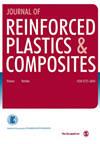堆叠顺序、金属片和纳米颗粒对 FML 强度和韧性的影响
IF 2.2
3区 材料科学
Q3 MATERIALS SCIENCE, COMPOSITES
引用次数: 0
摘要
本研究探讨了纳米颗粒的加入和堆叠顺序/金属体积分数对金属纤维层压板(FML)的拉伸强度和能量吸收性能的影响。FML 结构由航空航天级铝合金 7075 的轻质薄片和单向玻璃纤维复合片组成,以 Araldite LY5052 热固性环氧系统为基体。FML 结构中铝板的体积分数随铝板数量的变化而变化,铝板数量从 2 块增加到最多 4 块。在第二批中,环氧树脂基体中加入了多壁纳米碳管和纳米金刚石颗粒,各占 0.15 wt%。这样做的目的是增强环氧树脂基体的性能,以提高层间(玻璃纤维增强塑料和铝)的附着力。拉伸试验结果表明,随着金属体积分数的增加,拉伸强度和能量吸收能力(韧性)都有所提高。与不含纳米颗粒的 FML 相比,纳米增强材料的加入提高了 FML 结构的抗拉强度和韧性。加入纳米增强材料后,FML 结构的强度重量比也得到了提高,满足了航空航天应用的需要。本文章由计算机程序翻译,如有差异,请以英文原文为准。
Role of stacking sequence, metal sheets, and nano particle on strength and toughness of FMLs
The effect of nano particle inclusion and the stacking sequence/metal volume fraction on the tensile strength and energy absorption properties of Fiber Metal Laminates (FML) is investigated. The FML structure is composed of lightweight thin sheets of aerospace grade aluminum alloy 7075 and unidirectional glass fiber composite sheets with Araldite LY5052 thermoset epoxy system as the matrix. The volume fraction of aluminum sheets in the FML structure was varied by increasing the number of aluminum sheets from 2 to maximum 4. In the second batch, the epoxy matrix is reinforced with of multi-walled carbon nano tubes and nano diamond particles together, each with 0.15 wt%. The purpose is to enhance the properties of the epoxy matrix to facilitate higher inter-laminate adhesion (FRP and aluminum). The results of the tensile testing show that with the increase of the metal volume fraction, the tensile strength as well energy absorbing capability (toughness) both are increased. The inclusion of the nano-reinforcements has increased the tensile strength and the toughness of the FML structure as compared to that of the FMLs without nano particles. The strength-to-weight ratio of FML structures is also increased after the inclusion of nano reinforced as desired for aerospace applications.
求助全文
通过发布文献求助,成功后即可免费获取论文全文。
去求助
来源期刊

Journal of Reinforced Plastics and Composites
工程技术-材料科学:复合
CiteScore
5.40
自引率
6.50%
发文量
82
审稿时长
1.3 months
期刊介绍:
The Journal of Reinforced Plastics and Composites is a fully peer-reviewed international journal that publishes original research and review articles on a broad range of today''s reinforced plastics and composites including areas in:
Constituent materials: matrix materials, reinforcements and coatings.
Properties and performance: The results of testing, predictive models, and in-service evaluation of a wide range of materials are published, providing the reader with extensive properties data for reference.
Analysis and design: Frequency reports on these subjects inform the reader of analytical techniques, design processes and the many design options available in materials composition.
Processing and fabrication: There is increased interest among materials engineers in cost-effective processing.
Applications: Reports on new materials R&D are often related to the service requirements of specific application areas, such as automotive, marine, construction and aviation.
Reports on special topics are regularly included such as recycling, environmental effects, novel materials, computer-aided design, predictive modelling, and "smart" composite materials.
"The articles in the Journal of Reinforced Plastics and Products are must reading for engineers in industry and for researchers working on leading edge problems" Professor Emeritus Stephen W Tsai National Sun Yat-sen University, Taiwan
This journal is a member of the Committee on Publication Ethics (COPE).
 求助内容:
求助内容: 应助结果提醒方式:
应助结果提醒方式:


